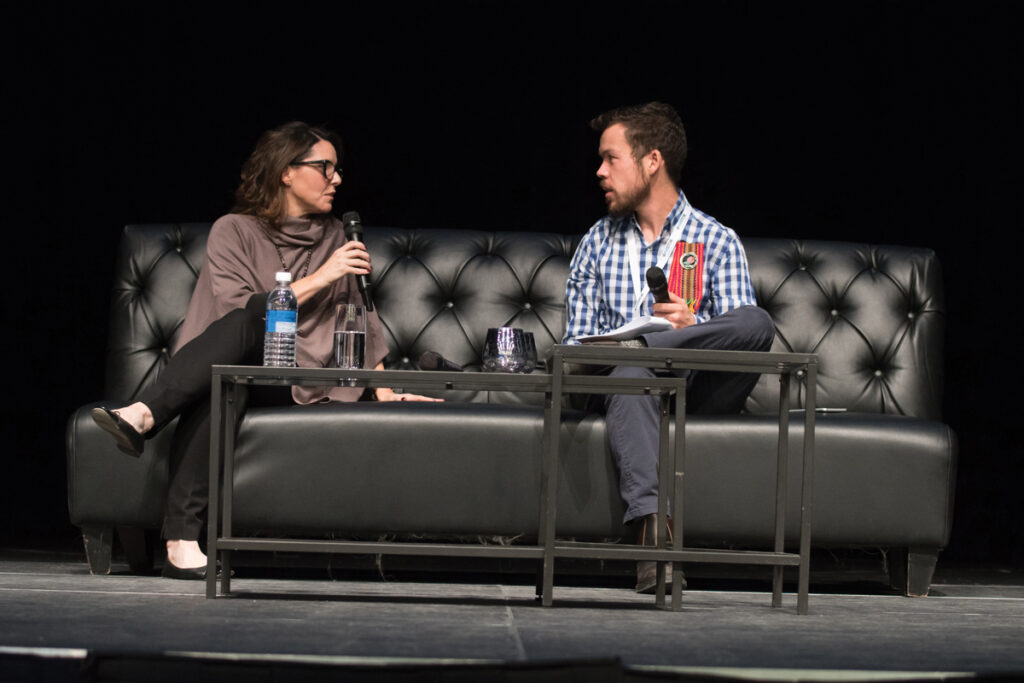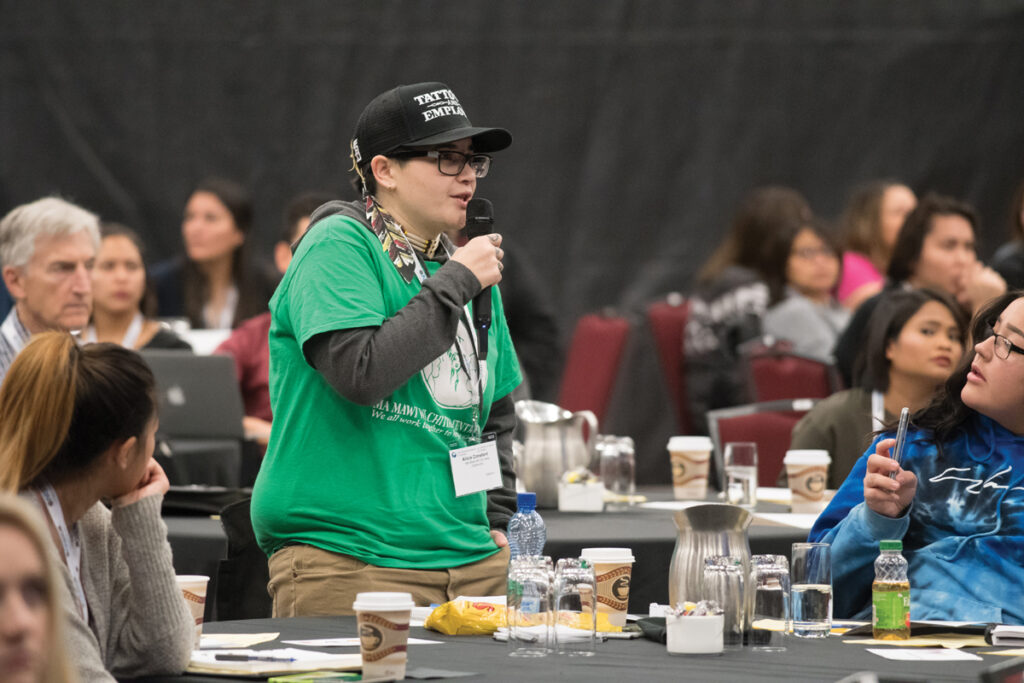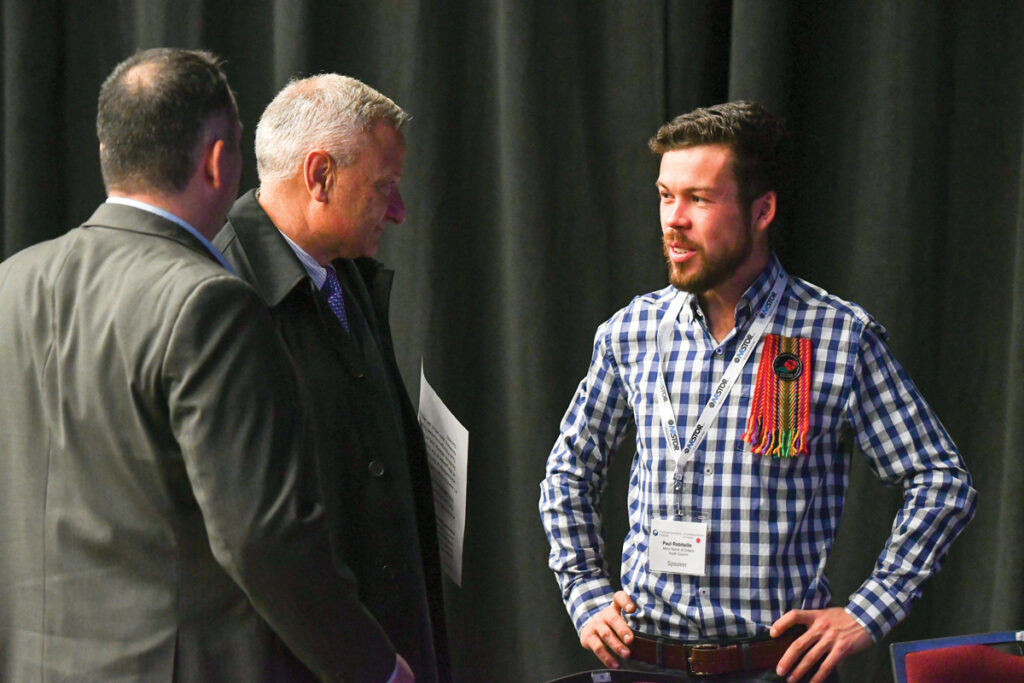A Youthful Approach to Resources
Engaging Indigenous Youth in Development on their Lands Can Lift the Aboriginal Economy While Protecting Traditional Cultural Values

Indigenous youth are the fastest growing segment of the Canadian population. According to Statistics Cana da, the average age of the Aboriginal population was 32.1 years in 2016 – almost a decade younger than the non-Aboriginal population of 40.9 years. Many of these will soon be leaders with growing authority over their traditional lands, bringing new opportunities and promise in natural resource development. So a solid understanding between industry and Indigenous youth about each other’s interests, needs, and challenges needs an updated look.
How to engage Indigenous youth in resource development – what industry needs to do, what First Nations need to do – was the focus of a recent two-day conference Our Land, Our Future: National Summit on Indigenous Youth and Natural Resources Development, by The Conference Board of Canada. Attended by stakeholders from all sides including several Indigenous youth organizations, a number of solid themes emerged pointing to a way forward that would benefit all players.
In the opening remarks, Chief Lee Crowchild, of the Tsuut’ina Nation, set the stage by stating the importance of resource development to First Nations but it’s imperative that it be done in a way that protects their land, language, culture, and identities for the long-term. Aimed at past government policies, he emphasized that it is truth, not reconciliation, that’s key. “The government should just tell the truth,” he said. “We wanted your land.” He said there is still a long way to go, and looked to today’s youth to make it happen.
Andy Moorhouse, Vice President of Economic Development at Makivik Corporation in the Nunavik region of Quebec, agreed to the importance of involving youth in managing their own resource development.
“It is a very important time to make sure we have the youth involved,” he told delegates. He said it may bring different dynamics, but it’s those new ideas that bring us closer to realizing responsible natural resource development.
B.C. Success Story
An example of a First Nation which has seen success involving youth in development was presented by Chad Day, President of the Tahltan Central Government in northwestern B.C. The Tahltan First Nation is rich in natural resources and hosts several large mining operations, so they have a major responsibility in protecting the land. “We have three separate headwaters to manage,” he said. And about 20 per cent of Tahltan territory is staked for minerals, which represents 30 per cent of all claims in the province. It includes the world’s largest undeveloped nickel deposit, he said.
To facilitate involvement of youth, in 1985 they established the Tahltan Nation Development Corporation (TNDC) to act as a training and employment hub for their people. And to monitor potential environmental impacts, they launched the Tahltan Heritage Resources Environmental Assessment Team (THREAT) two decades later. Day said THREAT enables Tahltan people to be more involved and feel safer when it comes to environmental stewardship in their territory.
Tahltan youth programs include daycare, cultural programs, and youth gatherings for the Tahltan, Kaska, and Tlingit people. Tahltan youth are further empowered through participation in their evolving central government in several departments including Employment and Training, Lands, Communications, Wildlife, and Administration; as well as the Tahltan Nation Education and Training Board and the more recent Tahltan Nation Constitution Working Group.
The result has been a responsible form of development which is especially important to the youth, said Day. The mining industry on their lands provides 250 to 300 jobs. Salaries average $90,000 per year. “Allowing the Tahltan to work in their own territory brings them home,” he said. “It empowers the youth.” He said adding jobs in the territory keeps youth connected to their ancestral lands. And the monetary benefits of resource development are a boon for individuals, as well as the broader

Other Perspectives, Too
Other Nations haven’t been so fortunate. Olivia Ikey, Vice President of the Qarjuit Youth Council, said natural resource development isn’t even on the minds of their youth today. Her people are interested in learning about it, but for the present are more concerned about their northern Quebec community with its alarmingly high youth suicide rate.
“We face a huge identity crisis,” she said. “Our people need to know our identity, our past. Our youth have no confidence. We have to boost that – no one is encouraging them.”
Their youth council was just founded in 2016 and she reckons it’s a “sleeping giant” enthusiastic that involving their youth in endeavours like natural resource development can lift them and benefit the community.
Rosalie LaBillois, New Brunswick youth representative from the Assembly of First Nations National Youth Council, has similar concerns.
“Addictions are just symptoms that things aren’t right,” she said, citing colonization and money handouts as others. “If our community would benefit, we should go for development.”
She added that communities and centres need to be more proactive in doing so.
Mitchell Case, President of the Métis Nation of Ontario Youth Council, said communities need to come together and celebrate together. He said developing their resources is important in accomplishing that, because “when people leave for other jobs, they don’t come back home. A development economy can keep them.”
But importantly, he added, they must have clean rivers and sustainable wildlife, like moose. To accomplish that, he figures they should stop depending on the federal government and move toward their own control.

Advice to Developers
Smoothing the process is ensuring good relationships with resource companies. What practical advice would these progressive youth offer a development company wishing to engage a community?
Melody Teddy, Inuvialuit youth representative with the National Inuit Youth Council, emphasized the need to relate in a way that’s understandable to the youth.
“It has to be very hands on,” she said. “They can’t just be sitting there giving a presentation, going from one slide to the next.” She said there must be no question as to what the company wants to do, how they want to do it, and what would be the positive and – just as importantly – the negative impacts of any proposed development.
Ikey agreed. She advocated going to the youth centres, the schools, the radio stations. “No community centre presentations wearing a suit and tie – this doesn’t engage youth in Nikes,” she said. “Even try to include Facebook.” Case re-emphasized this point. “It needs to be a genuine conversation with youth,” he said.
LaBillois added, companies must point out the future, know who we are, where we come from, and know our heritage.
As well as industry and Aboriginal communities, the government has a role to play in engaging Indigenous youth in natural resource development and paving for the future. Kim Rudd, Parliamentary Secretary to the federal Minister of Natural Resources, pointed out that Canada is approaching an inflection point when it comes to natural resource development: energy sources are going renewable. Which opens up tremendous new opportunities, new innovations, and new ideas – these are often led by young people, she said.
“Youth bring the excitement and enthusiasm needed to get people together that don’t normally get together,” she said. “Youth are more connected, not afraid to challenge; don’t just accept things.” They bring a passion for the environment, she added, because of their people’s traditionally strong bonds with the land.
She said the confluence of two historical events now happening – government reconciliation and the energy transition – presents an excellent opportunity for Indigenous youth to lead the new direction.

Pros and Cons
With a Mi’kmaq father who worked for Syncrude, and growing up in Fort McMurray, Alicia Dubois, Market Vice President of Indigenous Banking with CIBC Investor Services, was influenced first-hand by the pros and cons of resource development.“The tailings ponds were something that really created conflict for [my father],” she recalled, “because it was a symbol of what his work was doing to the environment.” With that understanding, she offered that non-Indigenous people often don’t fully appreciate environmental impacts to the same degree as their Indigenous counterparts. “There is such an intrinsic connection to the land that is very difficult to explain to people who do not understand this and who do not feel this,” she said. “The land for them is property, an asset, a means to make money, and not part of their social, spiritual, cultural experience.”
But there are no right answers, she said. There are clear pros and cons to natural resource development. She highlighted obvious benefits of meaningful Indigenous engagement with industry and resource development, which includes economic strength and stability to enhance community well-being and the ability to fund important programs that serve their citizens.
“It also offers employment and skills development,” she said, noting industrial development can give Indigenous communities a voice. And when Indigenous communities can build strong partnerships with industry and create economic strength, it acts to combat negative stereotypes often associated with Aboriginal Canadians.
Dubois appealed to corporate Canada to engage Indigenous youth when it comes to resource development. Not only does it make economic sense, she said, it also comes down to the future – the young people of these communities are the ones who will maintain the longevity of resource development projects. Moreover, “the youth are tech-savvy; and they want long-term success,” she said.
On the other hand, when opportunities for resource development come to Indigenous communities, Dubois encouraged youth to seriously consider them on a case-by-case basis, and to not simply shun the idea of any partnerships with industry.
“It’s about being open, understanding your values and being firm in them,” she said. “But also being prepared to be part of the conversation. I think that is really key.”
Presented with all these opportunities, it will be a challenging time for Indigenous youth. The final session linked three panelists who offered supporting advice for them.
Ken Coates, Canada Research Chair in Regional Innovation at the University of Saskatchewan, suggested finding people who can help them through; allies in the non-First Nations community can be their mentor. It is important, he said, because, “within 10 years, many of the largest billion-dollar corporations will be Aboriginal.”
Brian Titus, Vice-Chair and Acting Chief Operating Officer of the First Nations Financial Management Board, said “there will be a lot of changes coming. If you don’t know, ask – there is always someone who has experienced it.”
Dave Bradley, Director of Indigenous Workforce Development with Outland Camps Inc., suggested youth go and join the resource companies even if they don’t like what the companies are doing.
“You will learn what’s going on,” he summed.
The thread running through the two days of discussions overwhelmingly identified Indigenous youth as well-positioned to boost the Aboriginal economy through sustainable natural resource development. They are the ones to bridge the traditional past with the high-tech future; to efficiently develop resources while protecting the land well into the coming centuries.
Chief Crowchild threw down the challenge: “To the youth: you have a big responsibility, lead the charge.”

